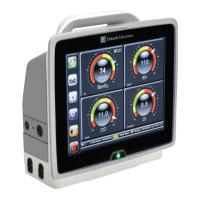HemoSphere Advanced Monitor 12 Advanced Features
153
12.1.2 P(↓BP) as a Key Parameter
Once the HPI feature is activated, the user can configure P(↓BP) as a key parameter using the steps described
in Change Parameters on page 66.
The display of P(↓BP) differs in several ways from other key parameters. Display of other key parameters is
described in Status Indicators on page 67.
Table 12-3 describe the similarities and differences between P(↓BP) and other key parameters.
Table 12-3 P(↓BP) versus other key parameters: similarities and differences
Similarities Differences
• Values update every 20 seconds
• Audible alarm when > alarm limit
• Visual alarm when > alarm limit
• Can display % change, if configured
• Audible alarm can be disabled
•P(↓BP) key parameter globe does not have a circle
•P(↓BP) key parameter globe does not have colored lan-
tern value in colored font, depending on clinical/alarm
indicator status
•P(↓BP) key parameter globe has shortcut key in top-
right corner to provide direct access to HPI Secondary
Screen
•P(↓BP) will display Alert popup when P(↓BP) exceeds
high alarm limit for two consecutive updates or P(↓BP)
value is 100%
•P(↓BP) only available as key parameter if activation key
entered
•P(↓BP) alarm limits are not adjustable
•P(↓BP) does not have a target, green-shaded region
with red arrows at the upper and lower limits when dis-
played as a trend on the main monitoring screen
because it is not a physiologic parameter with a target
range. Instead P(↓BP) is a quantitative indication of
physiological status used to inform users of patient like-
lihood of trending toward a hypotensive event. Specifi-
cally:
* When P(↓BP) is less than or equal to 50% the
graphic elements (displayed number trend line or
dial segment) are green and clinician should con-
tinue monitoring patient hemodynamics
* When P(↓BP) exceeds 50% but is less than or
equal to 85%, the graphical elements (displayed
number, trend line or dial segment) appear yellow
indicating the user should heighten vigilance with
respect to changing patient hemodynamics using
the secondary screen and other monitoring screen
parameters and monitor both P(↓BP) value and the
slope of its trend line for changes
* When P(↓BP) exceeds 85%, the graphical elements
(displayed number, trend line, or dial segment)
appear red indicating the user should check patient
hemodynamics using the secondary screen and
other monitoring screen parameters in order to
investigate the potential cause of the high probabil-
ity of hypotension (or hypotension if P(↓BP) =
100%) in order to inform a potential course of action
Status = Released Printed Date: 2018-01-16 Released Date: 2017-09-14

